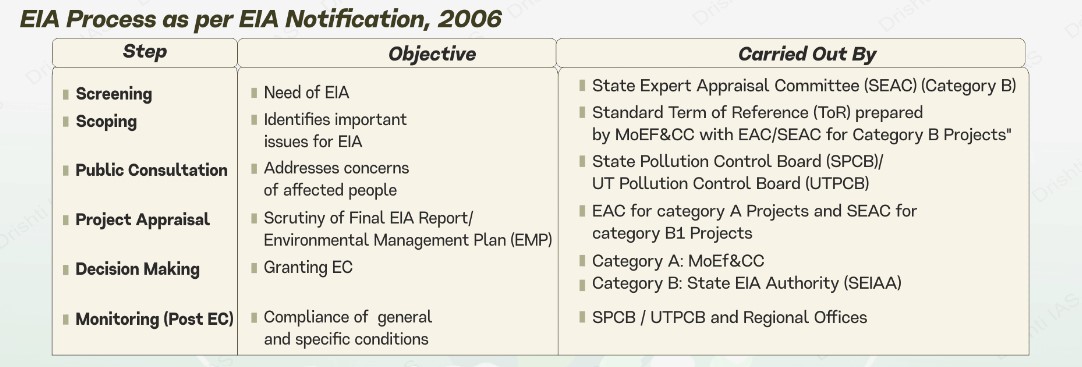-
13 Aug 2024
GS Paper 3
Bio-diversity & Environment
Day 32: The current Environment Impact Assessment (EIA) framework in India falls short of recognizing the special requirements of the Indian Himalayan Region (IHR).Examine.(150 words)
Approach
- Briefly explain the concept of Environment Impact Assessment (EIA).
- Mention the Special Ecological Challenges Faced by the Himalayas.
- Discuss how the current EIA is affecting the Indian Himalayan Region.
- Suggest the way ahead for EIA in the Himalayas.
- Conclude Suitably.
Introduction
The EIA, as defined by the United Nations Environment Programme (UNEP), is a crucial tool for assessing the environmental consequences of projects before they are executed. It involves comparing project alternatives, predicting environmental impacts, and formulating mitigation strategies.
Body
Special Ecological Challenges Faced by the Himalayas :
- Ecological Fragility:
- The Himalayas are young, fold mountains which means they are still rising and are prone to tectonic activities. This makes the region prone to natural disasters such as landslides, avalanches, and earthquakes.
- Extreme Weather and Climate Change:
- The Himalayas are prone to extreme weather conditions such as heavy rains, flash floods, landslides, and seismic activity. Climate change exacerbates these vulnerabilities. The absence of region-specific standards fails to address these pressing issues.
- Accumulation of Black Carbon:
- One of the biggest factors causing glaciers to melt is the emission of black carbon aerosols into the atmosphere.
- Black carbon absorbs more light and emits infra-red radiation that increases the temperature, therefore, an increase in black carbon in the Himalayas contributes to the faster melting of glaciers.
- Anthropogenic Challenges:
- Deforestation, construction activities,unregulated tourism and improper land use practices increase soil erosion and the risk of landslides.
- The loss of vegetative cover destabilises Himalayan slopes, making them susceptible to erosion during heavy rainfall or seismic events.
Current EIA affecting the Indian Himalayan Region :
- Faulty Ecological Assessment:
- Assessing the impacts of projects in the Indian Himalayan Region(IHR) requires a contextual understanding of the region's fragility and vulnerability. The current system does not provide for this critical perspective.
- Graded Approach and its Flaws:
- The Indian regulatory system employs a graded approach, with environmental conditions varying depending on the type of habitat impacted by a project. This approach lacks differentiation for the IHR , leaving the region without specialized protection.
- Exemptions under EIA:
- Projects belonging to certain categories such as Strategic and Defence Projects, Biomass Based Power Plants, Ports and Harbour dealing in Fish, Toll Plazas are exempted from EIA based on certain criteria.
The Way Ahead for EIA in the Himalayas :
- Need for a National Regulator:
- The absence of a national-level regulator, as suggested by the Supreme Court in 2011, hinders objective and transparent project appraisal and monitoring. An independent regulator could help ensure a more equitable balance between development and environmental preservation.
- Cumulative Impact Assessment:
- The EIA process, as it stands, does not adequately consider cumulative impacts. It focuses on individual projects rather than assessing the combined effects of multiple projects in a specific area. For the IHR, a more holistic view is required.
- Strategic Impact Assessment:
- Strategic environmental assessment (SEA), is the assessment of the wider environmental, social and economic impacts of alternative proposals at the beginning of a project. That is, at the decision stage - the policy, planning or program (PPP) level.
- Proactive Role of EIA Authorities:
- It is crucial that EIA authorities anticipate developmental activities rather than reacting to it.
- It is critical that the preparation of an EIA is completely independent of the project proponent.
- Banning Construction Activities : Complete ban on construction activities in disaster prone areas such as Joshimath as suggested by Mishra Committee,1976.
Conclusion
The current Environment Impact Assessment (EIA) framework in India falls short in recognizing the special requirements of the Indian Himalayan Region (IHR), which is characterized by its fragility and vulnerability. To ensure sustainable development in this ecologically vital region, there is an urgent need to reevaluate the EIA process.Only by adopting a region-specific and holistic approach can we safeguard the fragile ecosystems of the IHR while pursuing responsible development.





